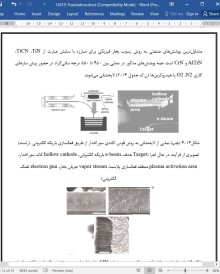
دانلود مقاله مهندسی سطح و تولید در ابعاد کوچک
مقدمه
مهندسی سطح
فناوری پیشرفته سطح یا مهندسی سطح یک حوزه دانشبنیان است که در بسیاری از فرآیندهای صنعتی و تولید کالا به کار گرفته میشود. مهندسی سطح شامل آن دسته فناوریهایی میشود که قابلیت اصلاحِ سطح مواد جامد را دارند تا عملکرد بهتر و یا خواص جدیدی به آنها بخشیده شود.
در طول دهههای اخیر بخشی از مهندسی سطح به حفاظت از سطوحِ ابزارهای تولید و اجزای صنعتی اختصاص داده شده است که در شرایط بسیار سختی از نظر اصطکاک، سایش، اکسیداسیون یا خوردگی کار میکنند. معمولاً به این پدیدهها به عنوان کاتالیستهایی نگاه میشود که باعث تخریب سطح میشوند. سالانه هزینههای هنگفتی از تولید به شکلدهی مجدد یا جایگزینی ابزار و دورریز قطعات اختصاص پیدا میکند. بر اساس برآوردها در کشورهای توسعهیافته، تخریب سطحی تا حدود 4% از تولید ناخالص داخلی را هدر میدهد. به عنوان نمونه، در ایالات متحده آمریکا تقریباً 280 میلیارد دلار در سال از طریق تخریب سطح تلف میشود. علاوه بر این، دیگر مطالعات تخمین میزنند که تنها در آلمان، مصرف روانکارهای مشتقشده از نفت به منظور پیشگیری از سایش سالانه 1 تا 2 میلیارد دلار هزینه برای صنایع تولیدی به دنبال دارد. هزینههای اضافی مرتبط با حفاظت از سطح شامل ایجاد مواد باقیماندهای نظیر هگزاوالانت کروم است که در حین بکارگیری روش گالوانیک به وجود میآید.
مهندسی سطح با چالشهای جدید و هیجانانگیزی در زمینه فناوریهای تولید در مقیاس میکرو و نانو روبرو است. درآینده، فرآیندهای اصلاح سطحی نقشی اساسی در تواناسازی صنایع در فناوریهای مختلف بازی خواهند کرد که از جمله آنها فناوری های میکرو شکلدهی، میکرو ماشینکاری یا میکروبافتبندی است. علاوه بر این، از فناوریهای جدید و نوظهور انتظار میرود تا سطوح جدیدی معرفی کنند که عملکرد آنها بهتر از نمونههای موجود باشد. از جمله زمینههایی که به دنبال سطوح جدید میگردند میتوان از 1- زیستمواد 2- انرژیهای تجدیدپذیر نام برد. حوزه زیستمواد به فناوریهای پیشرفته برای عاملدارکردن زیستی سطوح خود نیاز دارند و انرژیهای تجدیدپذیر به مهندسیکردن غشاهای عاملدارشده و دیگر پوششهای عاملدار برای سلولهای فسیلی H2 نیاز دارند.
بنیانهای فرآیند مهندسی سطح پیشرفته برای حفاظت از ابزار
در این بخش، انواع روشهای اصلاح سطحی برای حفاظت از ابزار مرور خواهد شد. فناوریهای حفاظت از سطح در سالیان اخیر به منظور انجام حفاظت از مواد دلخواه توسعه یافتهاند که به محیط، شرایط کاری و سازگاری میان عمل لایهنشانی و ماده زیرلایه وابسته است. انواع مختلفی از روشهای اصلاح سطحی وجود دارند که تاثیر خود را برای حفاظت از سطح و دیگر اهداف عاملدارکردن نشان دادهاند و هماکنون در مقیاس صنعتی به کار گرفته میشوند. به طور کلی، تمام عملیات سطحی در سه طبقه جای میگیرند: عاملدارکردن فیزیکی-شیمیایی، عاملدارکردن مکانیکی-ساختاری و پوشش سطحی که در شکل 14-1 به نمایش درآمده است.
در تولید مقیاس کوچک، ابزارهای زیرمیلیمتری خواص ویژهای از خود نشان میدهند که کاربستپذیری برخی از تکنیکها برای حفاظت از سطوح آنها را محدود میسازد. برای مثال، تکنیکهای سطحی در مورد ابعاد زیرمیلیمتری نباید باعث تغییر در شکل کلی (Net-shape) ابزار شود چون ممکن است عملکرد یا دقت ابزار را کاهش دهد. علاوه بر این، عملیات سطحی که در دماهای بالا صورت میگیرد احتمالاً باعث تخریب خواص مکانیکی بالکِ ماده ابزار خواهد شد. این فصل، مجموعهای از تکنیکهای خاص را عرضه میکند که تاثیر خود را در حفاظت از ابزارهای تولید در ابعاد خیلی کوچک به اثبات رساندهاند. این تکنیکها در دسته عاملدارکردن فیزیکی-شیمیایی شامل نیتریددارکردن پلاسما و گازی، کاشت یونی و تکنیکهای پوششدهی شامل روش رسوب الکتریکی، رسوب بخار شیمیایی (CVD) و رسوب بخار فیزیکی (PVD) جای میگیرند.
خلاصه
در این فصل، مرور جامعی بر پیشرفتهای اخیر در مهندسی سطح برای حفاظت از ابزار ارائه شد و توجه ویژهای بر کاربردها و فناوریهای مقیاس نانو صورت گرفت. نتیجهگیری کلی را میتوان چنین سامان داد که مهندسی سطح پتانسیل زیادی برای تاثیرگذاری در توسعه تولید در ابعاد میکرو و مینیاتوری دارد. به همین دلیل است که تحقیق و توسعه در این زمینه باید بر مفاهیم جدیدی تمرکز کند که سازگار با سیستمهای اصلاح سطحی باشند تا به عملکرد بهینهای در ابزار غیراستاندارد دست یافته شود. علاوه بر این، بکارگیری ابزارهای آزمون قابلاتکا و استانداردها باید به دقت انجام شود. توسعه ابزارهای مدلسازی سطح/فصلمشترک برای کمک به یکپارچهسازی هر دو مرحله طراحی مهندسی سطح در یک گام واحد برای تولید در ابعاد کوچک ضروری است. تلاشهای انکارناپذیری باید در انجمنهای عملی و ذینفعان صنعتی در این حوزه انجام شود تا همه ظرفیتهای مهندسی سطح بارور شده و ثمره این تلاشها فناوری راستینی برای تولید در ابعاد میکرو باشد.
INTRODUCTION
Surface Engineering
Advanced surface technology or surface engineering is a key knowledge-based sector of great relevance for several manufacturing processes and consumer goods production. Surface engineering encompasses those technologies capable of modifying the surfaces of solids to provide them with superior performance or new functionalities.
During recent decades, part of the surface engineering sector has been devoted to the protection of the surfaces of manufacturing tools and industrial components working under severe conditions of friction, wear, oxidation or corrosion. These phenomena are usually considered as catalysts of surface degradation, and yearly they cause huge production costs mainly related to tool reshaping or replacement, as well as component rejection. It is estimated that, in developed economies, surface degradation might cause losses of up to 4% of the GDP. For the USA these features represent approximately $280 billion/ year. Moreover, other studies estimate that in Germany alone, the consumption of oil-derived lubricants for wear prevention represents up to $1–2 billion/year [1] for manufacturing industries. Additional costs related to surface protection are those caused by the generation of residues derived from galvanic techniques (e.g. hexavalent chromium).
Surface engineering is facing new and exciting challenges from the advent of micro- and nanomanufacturing technologies (MNT), and surface modification processes will have a major role in enabling the industrialization of several technologies in the near future, such as micro-forming, micro-machining, or micro-nano-texturing. Moreover, new and emerging technologies need to find novel functional surfaces which could introduce new products able to outperform those already existing from classical concepts. Some examples are: (1) bio-materials, which require advanced techniques for surface bio-functionalization; or (2) renewable energy, through the engineering of functional membranes and other functional coatings for H2 fuel cells.
FUNDAMENTALS OF ADVANCED SURFACE ENGINEERING PROCESSES FOR TOOLING PROTECTION
In this section, different advanced surface modification processes for tooling protection will be overviewed. Surface protection technologies have been developed during recent years in order to accomplish optimal material protection, depending on the environment, the working conditions, and the compatibility between the treatment itself and the substrate material. There exists a large variety of surface treatment techniques which have demonstrated their performance for surface protection or other functionalization purposes, and therefore they are already implemented at industrial scale. In general terms, all surface treatments can be classified within three main categories: physical–chemical functionalization, mechanical-structural functionalization, and surface coating, as illustrated in Figs. 14-1.
In the case of micro-manufacturing, tools of sub-millimeter dimensions exhibit special features which limit the applicability of several of these techniques for surface protection. For instance, surface techniques must in this case prevent changes of the net-shape of a tool which could reduce its performance or precision. Analogously, treatments carried out at excessive temperatures might degrade the bulk mechanical properties of the tool. In this context, this section presents a series of particular techniques which have proven their effectiveness in protecting small-size manufacturing tools. These techniques are framed within the groups of physical–chemical functionalization, including gas and plasma nitriding, ion implantation, and coating techniques, including electro-deposition, chemical vapor deposition (CVD), and physical vapor deposition (PVD).
SUMMARY
In this chapter a concise review of recent progress in surface engineering for tooling protection has been presented, with particular focus on applications in micro- and nano-production technologies. As a general conclusion, it can be stated that surface engineering has the potential for great impact in the further development of miniature and micro-manufacturing. In this context, research and development in this field should focus on new concepts of flexible surface modification systems, in order to achieve an optimal performance on non-standard tooling elements. Moreover, the implementation of reliable testing tools and standards needs to be addressed in detail. The development of surface/interface modeling tools is envisaged to help in the integration of both process design and surface engineering for micro-manufacturing. Substantial integrative endeavors need to be undertaken between the scientific community and the relevant industrial stakeholders to obtain the full potential of surface engineering and to convert it in a true enabling technology for micro-manufacturing.
مقدمه
مهندسی سطح
پدیده تماس سطحی و تریبولوژی
تکنیکهای شناسایی
بنیانهای فرآیند مهندسی سطح پیشرفته برای حفاظت از ابزار
عاملدارکردن به روش فیزیکی شیمیایی بخش اول: نیتریددارکردن حرارتی و پلاسما
عاملدارکردن فیزیکی-شیمیایی بخش دوم: کاشت یونی
روشهای پوششدهی بخش اول: رسوب الکتریکی
روشهای پوششدهی بخش دوم: رسوب بخار شیمیایی
روشهای پوششدهی بخش سوم: رسوب بخار فیزیکی
کاربردهای مهندسی سطح در تولید ابعاد کوچک
پوششهای ضدچسبنده و مقاوم به سایش روی ابزارهای قالبگیری میکرو
تولید ابزار میکروشکلدهی با استفاده از فرآیندهای مهندسی سطح
خلاصه
منابع
INTRODUCTION
Surface Engineering
Surface Contact Phenomena and Tribology
Characterization Techniques
FUNDAMENTALS OF ADVANCED SURFACE ENGINEERING PROCESSES FOR TOOLING PROTECTION
Physical–Chemical Functionalization I: Thermal and Plasma Nitriding
Physical–Chemical Functionalization II: Ion Implantation
Coating Techniques I: Electro-deposition
Coating Techniques II: Chemical Vapor Deposition
Coating Techniques III: Physical Vapor Deposition
APPLICATIONS OF SURFACEENGINEERING PROCESSES IN MICRO-MANUFACTURING
Advanced Surface Treatments for Micro-cutting Tools
Anti-adhesion and Wear Resistance Coatings on Micro-molding Tools
Micro-forming Tool Fabrication using Surface-engineering Processes
REFERENCES
- اصل مقاله انگلیسی با فرمت ورد (word) با قابلیت ویرایش
- ترجمه فارسی مقاله با فرمت ورد (word) با قابلیت ویرایش، بدون آرم سایت ای ترجمه
- ترجمه فارسی مقاله با فرمت pdf، بدون آرم سایت ای ترجمه



